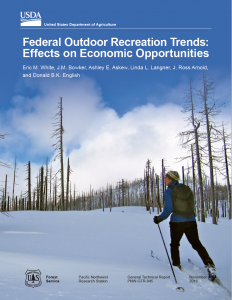Federal Outdoor Recreation Trends: Effects on Economic Opportunities
United States Department of Agriculture
US Forest Service
November 2016
Download full report: Federal Outdoor Recreation Trends: Effects on Economic Opportunities
White, Eric M.; Bowker, J.M.; Askew, Ashley E.; Langner, Linda L.; Arnold, J. Ross; English, Donald B.K. 2016. Federal outdoor recreation trends: effects on economic opportunities. Gen. Tech. Rep. PNW-GTR-945. Portland, OR: U.S. Department of Agriculture, Forest Service, Pacific Northwest Station. 46 p.
Outdoor recreation is a central way that people interact with the natural environment. Federal land agencies are key providers of settings, facilities, and landscapes for recreation. Outdoor recreation is also an important driver of economic activity in rural communities near recreation destinations and across the United States. Future participation in outdoor recreation, and associated economic activity, will be influenced by demographic changes in population, lowering per capita land available for recreation, and changing recreation resource conditions, influenced partially by climate change. In this report, we summarize recent trends and current projections to 2030 of recreation participation and total days of recreation for 17 key outdoor recreation activities common on federal lands. We report the current economic activity supported by outdoor recreation on the seven agencies participating in the Federal Interagency Council on Outdoor Recreation and describe how anticipated future changes in recreation participation and climate may change the economic activity supported by outdoor recreation. Keywords: Outdoor recreation, trends and projections, climate change impacts, demographic trends, federal lands, recreation opportunities, trip spending patterns, economic contributions.
Introduction:
Outdoor recreation plays a significant role in American lives. It provides physical challenges and a sense of well-being, helps develop lifelong skills, provokes interest and inquiry, inspires wonder and awe of the natural world, and often provides an alternative to daily routines. Recreation contributes greatly to the physical, mental, and spiritual health of individuals; bonds family and friends; and instills pride in natural and cultural heritage. Federal lands contribute significantly, and in many cases uniquely, to the provision of nature-based outdoor recreation opportunities. This report, prepared for the Federal Interagency Council on Outdoor Recreation (FICOR), focuses on the potential future role of federal lands in supplying outdoor recreation opportunities and therefore supporting associated jobs and income. The FICOR is a seven-agency council that promotes better coordination and collaboration among federal agencies whose missions or programs include providing outdoor recreation and conserving or managing natural and cultural resources. The FICOR agencies include the U.S. Department of the Interior (USDI), Bureau of Land Management (BLM), Bureau of Reclamation (BOR); Fish and Wildlife Service (FWS), National Park Service (NPS); U.S. Department of Agriculture Forest Service (FS); U.S. Department of Comerce (USDC); U.S. Department of Defence (USDOD); National Oceanic and Atmospheric Administration (NOAA), and the Army Corps of Engineers (USACE). We begin with an overview of recent trends in outdoor recreation activity participation in the United States and projected recreation participation to 2030. The primary driving forces for participation are reviewed, and their effects on future recreation use are discussed. The federal land base for outdoor recreation and expectations for future availability are also described. Recreation visitation in 2012 on lands and waters managed by the FICOR agencies and the associated jobs provide the baseline for considering how projected recreation use might influence future economic effects. The “future” look takes into account (1) the key factors that determine the level of economic activity in and around federal lands, (2) potential changes in recreation activities and associated spending patterns, and (3) other factors that influence spending. Finally, we discuss other contributions to local economies that may be influenced by federal recreation opportunities, including amenity migration, business relocation, and natural backdrops.

